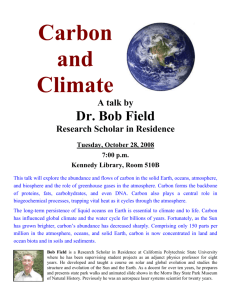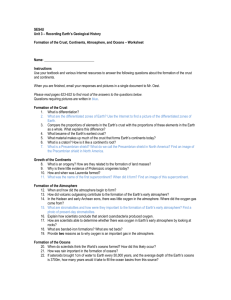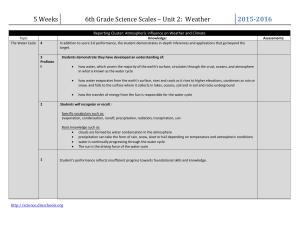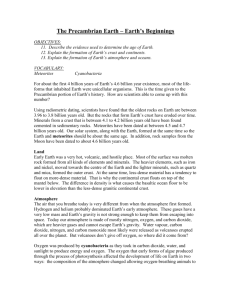HOME sequence one Understanding. 1. When did life first appear
advertisement
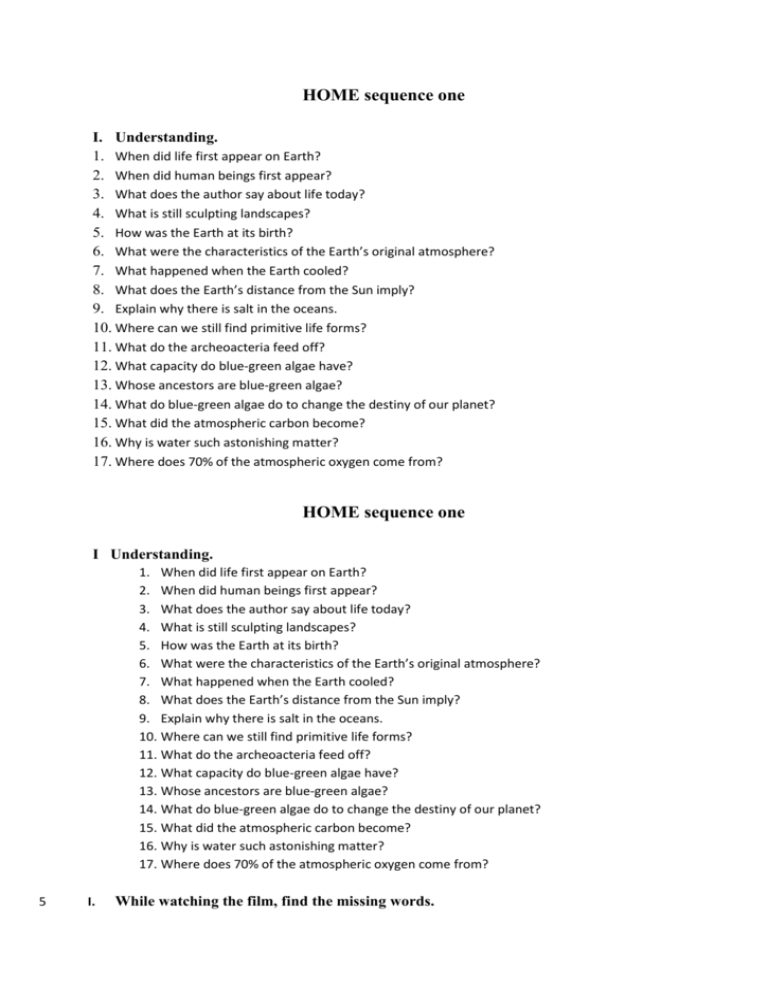
HOME sequence one I. Understanding. 1. When did life first appear on Earth? 2. When did human beings first appear? 3. What does the author say about life today? 4. What is still sculpting landscapes? 5. How was the Earth at its birth? 6. What were the characteristics of the Earth’s original atmosphere? 7. What happened when the Earth cooled? 8. What does the Earth’s distance from the Sun imply? 9. Explain why there is salt in the oceans. 10. Where can we still find primitive life forms? 11. What do the archeoacteria feed off? 12. What capacity do blue-green algae have? 13. Whose ancestors are blue-green algae? 14. What do blue-green algae do to change the destiny of our planet? 15. What did the atmospheric carbon become? 16. Why is water such astonishing matter? 17. Where does 70% of the atmospheric oxygen come from? HOME sequence one I Understanding. 1. When did life first appear on Earth? 2. When did human beings first appear? 3. What does the author say about life today? 4. What is still sculpting landscapes? 5. How was the Earth at its birth? 6. What were the characteristics of the Earth’s original atmosphere? 7. What happened when the Earth cooled? 8. What does the Earth’s distance from the Sun imply? 9. Explain why there is salt in the oceans. 10. Where can we still find primitive life forms? 11. What do the archeoacteria feed off? 12. What capacity do blue-green algae have? 13. Whose ancestors are blue-green algae? 14. What do blue-green algae do to change the destiny of our planet? 15. What did the atmospheric carbon become? 16. Why is water such astonishing matter? 17. Where does 70% of the atmospheric oxygen come from? 5 I. While watching the film, find the missing words. Listen to me, please. You're like me, a homo sapiens, a …………….. human. Life, a miracle in the universe, appeared around …………….years ago. And we humans only ……………… years ago. Yet we have succeeded in ……………… the balance so essential to life. Listen carefully to this extraordinary story, which is yours, and decide what you want to do with it. These are traces of our 10 origins. At the beginning, our planet was no more than a …….. of fire, a cloud of agglutinated dust particles, like so many similar ………….. in the universe. Yet this is where the miracle of life ……………. Today, life, our life, is just a link in a chain of innumerable …………….. ……….. that have succeeded one another on Earth over nearly 4 billion years. 15 And even today, new volcanoes continue to sculpt our ……………... They offer a ………………. of what our Earth was like at its birth, …………….. rock surging from the depths, solidifying, cracking, ……………….. or ……………… in a ………. crust, before falling dormant for a time. These ……………. of smoke curling from the ……………. of the Earth, bear witness to the Earth's original atmosphere. An atmosphere …………..of oxygen. 20 A dense atmosphere, …………….with water vapor, full of carbon dioxide. A ………………. The Earth cooled. The water vapor condensed and fell in torrential …………... At the right distance from the sun, not too far, not too near, the Earth's perfect balance ………….. it to conserve water in liquid form. The water cut………….. They are like the veins of a body, the branches of a tree, the 25 vessels of the ……….that the water gave to the Earth. The rivers ……….. minerals from rocks, adding them to the oceans' ………………. . And the oceans became heavy with salt. Where do we come from? Where did life first ………… into being? A miracle of time, primitive life forms still exist in the globe's hot springs. They give them their 30 colors. They're called archeobacteria. They all feed off the Earth's heat. All except the cyanobacteria, or …………… algae. They alone have the capacity to turn to the sun to capture its energy. They are a vital ancestor of all yesterday's and today's plant species. These ………. bacteria and their billions of descendants changed the destiny of our planet. They transformed its atmosphere. What happened to the carbon that ………….. the atmosphere? 35 It's still here, imprisoned in the Earth's crust. Here, there once was a sea, inhabited by microorganisms. They grew shells by ………… into the atmosphere's carbon now dissolved in the ocean. These strata are the accumulated …………. of those billions and billions of micro-organisms. Thanks to them, the carbon drained from the atmosphere and other life forms could develop. It is life that …………. the atmosphere. Plant life fed off the sun's energy, which enabled it to break apart the 40 water molecule and take the oxygen. And oxygen filled the air. The Earth's water cycle is a process of constant ……………… Waterfalls, water vapor, clouds, rain, springs, rivers, seas, oceans, glaciers...The cycle is never broken. There's always the same quantity of water on Earth. All the successive species on Earth have drunk the same water. The ……………….. matter that is water. One of the most unstable of all. 45 It takes a liquid form as running water, gaseous as vapor, or solid as ice. In Siberia, the frozen surfaces of the lakes in winter contain the trace of the forces that water ……………..when it freezes. Lighter than water, the ice floats. It forms a protective mantle against the cold, under which life can go on. The engine of life is …………….. . Everything is linked. Nothing is self-sufficient. Water and air are inseparable, united in life and for our life on Earth. ………….. is everything. 50 The green ……………. through the clouds is the source of oxygen in the air. 70% of this gas, without which our ………….cannot function, comes from the algae that ……….. the surface of the oceans. Correction 1. Life appeared on Earth around 4 billion years ago. 2. Human beings appeared two hundred thousand years ago. 3. The author says that today our life is just a link in a chain of innumerable living beings that 4. 5. 6. have succeeded one another on Earth over nearly 4 billion years. New volcanoes are still continuing to sculpt our landscapes. At its birth, the Earth was made of molten rock, solidifying, cracking, blistering or spreading in a thin crust. The Earth’s original atmosphere was devoid of oxygen, dense, thick with water vapour, full of carbon dioxide, it was a furnace. When the Earth cooled, the water vapour condensed and fell in torrential downpours 7. 8. The right distance from the Sun, not too far and not too near to enable the Earth to conserve water in liquid form. 9. There is salt in the oceans because rivers erode the minerals from the rocks, adding them 10. 11. 12. 13. 14. to the oceans' freshwater. Primitive life forms still exist in the globe's hot springs. The archeoacteria feed off the Earth's heat except for the cyanobacteria, or blue-green algae. They alone have the capacity to turn to the Sun to capture its energy. They are a vital ancestor of plant species, past and present. They changed the destiny of our planet because they transformed its atmosphere by breaking apart the water molecule and taking the oxygen to fill atmosphere with it. 15. It's still here, imprisoned in the Earth's crust, because the seas are inhabited by micro- organisms which grew shells by tapping into the atmosphere's carbon which has now dissolved in the ocean. 16. Water is astonishing matter because it is one of the most unstable of all. It takes liquid form as in running water, a gaseous form such as vapour, or it can be solid, like ice. 17. 70% of atmospheric oxygen comes from the algae that tint the surface of the oceans.

